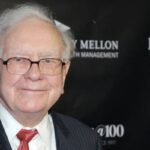We adhere to strict standards of editorial integrity to help you make decisions with confidence. Some or all links contained within this article are paid links.
In 2012, Warren Buffett told CNBC that if there was a way to buy thousands of single-family homes at once, and to manage them easily, he would “load up.”
He also emphasized he’d take out mortgages at “Very, very low rates.”
For Buffett, those low mortgage rates were what made housing such a great opportunity. He’s a value investor after all, which means he seeks investments with low prices relative to what they’re actually worth.
Don’t miss
- I’m 49 years old and have nothing saved for retirement — what should I do? Don’t panic. Here are 6 of the easiest ways you can catch up (and fast)
- Robert Kiyosaki warns of a ‘Greater Depression’ coming to the US — with millions of Americans going poor. But he says these 2 ‘easy-money’ assets will bring in ‘great wealth’. How to get in now
- Gain potential quarterly income through this $1B private real estate fund — even if you’re not a millionaire. Here’s how to get started with as little as $10
And at the time, consumer confidence was low, driving housing prices down. Buffett’s advice in those market moments? “Be greedy when others are fearful.”
Indeed, it would have paid off for the typical American homebuyer. The median price of an American home was $180,000 in 2012. As of April 2025, this figure is now $414,000. The all-time high was $426,900 in June 2024.
The question is, with prices and interest rates now so much higher than they were, would Buffett’s sentiment still hold for real estate as an investment now?
Invest with a mortgage
The average rate for a 30-year mortgage was 3.65% in 2012. These days, a 30-year fixed mortgage rate is around 6.86%
So, Buffett would probably be a little bit less jazzed on home buying in 2025.
That said, markets are cyclical. Usually — or at least in the world of interest rates — what goes up will eventually come down.
No matter what happens to interest rates, you’ll want to ensure you’re shopping around for the best rate possible — because the search really does pay off.
According to research from Freddie Mac, borrowers who applied for mortgages from two lenders saved up to $600 annually. If they applied for four or more, those cost savings doubled to $1,200 every year.
For an efficient way to shop for rates, Mortgage Research Center (MRC) helps you quickly compare rates and estimate your monthly payments from multiple vetted lenders. All you have to do is enter some basic information about yourself, such as your zip code, your desired property type, price range and annual income.
Based on the information you provide, MRC will show you mortgage offers tailored to your needs. After you match with a desired lender, you can set up a free, no-obligation consultation to see if you’ve found the right fit.
For those refinancing an existing mortgage, MRC can even help you find a better rate than what you currently have.
Read more: Want an extra $1,300,000 when you retire? Dave Ramsey says this 7-step plan ‘works every single time’ to kill debt, get rich in America — and that ‘anyone’ can do it
Become a landlord without the work
Buffett also clarified that in his dream world of buying all of those homes, he’d need to find an easy way to manage them as investments, too.
Several real estate crowdfunding platforms are currently stripping out the management and admin that’s usually required when you invest in real estate. This can make it easier than ever to tap into the real estate market.
For accredited investors, Homeshares gives access to the $34.9 trillion U.S. home equity market, which has historically been the exclusive playground of institutional investors.
With a minimum investment of $25,000, investors can gain direct exposure to hundreds of owner-occupied homes in top U.S. cities through their U.S. Home Equity Fund — without the headaches of buying, owning or managing property.
With risk-adjusted internal returns ranging from 12% to 18%, this approach provides an effective, hands-off way to invest in owner-occupied residential properties across regional markets.
Another option is targeted investments in hot real estate markets. Arrived has simplified the process, making it easy and accessible for everyday investors through the Seattle City Fund.
The fund takes a strategic advantage of Seattle, a global business hub and home to some of the world’s most influential companies, including Amazon, Microsoft, Starbucks and Boeing. Potential returns are generated through rental income and any appreciation in the value of properties within the fund. The average home value in Seattle is over $910,000, with a 10-year average appreciation of 95.5%, according to Redfin.com
The Seattle City Fund lets you capitalize on the city’s steady growth and increasing property values, giving you diversification across multiple properties. Each home in the fund is projected to have equity ranging from $800,000 to $900,000.
Then there’s commercial real estate. As an investment, it’s even more challenging to access and manage. And while some commercial investment opportunities are expected to witness weaker growth in 2025, they are not all one-and-the-same. Real estate for essential businesses, like grocery stores and health care facilities, is still popular because it has proven resilient to the broader e-commerce transition.
And First National Realty Partners allows accredited individual investors to access these types of necessity-based, institutional-quality commercial real estate investments — without having to do the research or manage tenants.
The FNRP team has relationships with the nation’s largest essential-needs brands, including Kroger, Walmart and Whole Foods, and provides insights into the best properties both on and off-market. And since the investments are necessity-based, they tend to perform well during times of economic volatility and act as a hedge against inflation.
You can engage with experts, explore deals, and easily make an allocation, all in one personalized portal.
What to read next
- JPMorgan sees gold soaring to $6,000/ounce — use this 1 simple IRA trick to lock in those potential shiny gains (before it’s too late)
- This is how American car dealers use the ‘4-square method’ to make big profits off you — and how you can ensure you pay a fair price for all your vehicle costs
- Here are 5 ‘must have’ items that Americans (almost) always overpay for — and very quickly regret. How many are hurting you?
- How much cash do you plan to keep on hand after you retire? Here are 3 of the biggest reasons you’ll need a substantial stash of savings in retirement
Like what you read? Join 200,000+ readers and get the best of Moneywise straight to your inbox every week. Subscribe for free.
This article provides information only and should not be construed as advice. It is provided without warranty of any kind.









